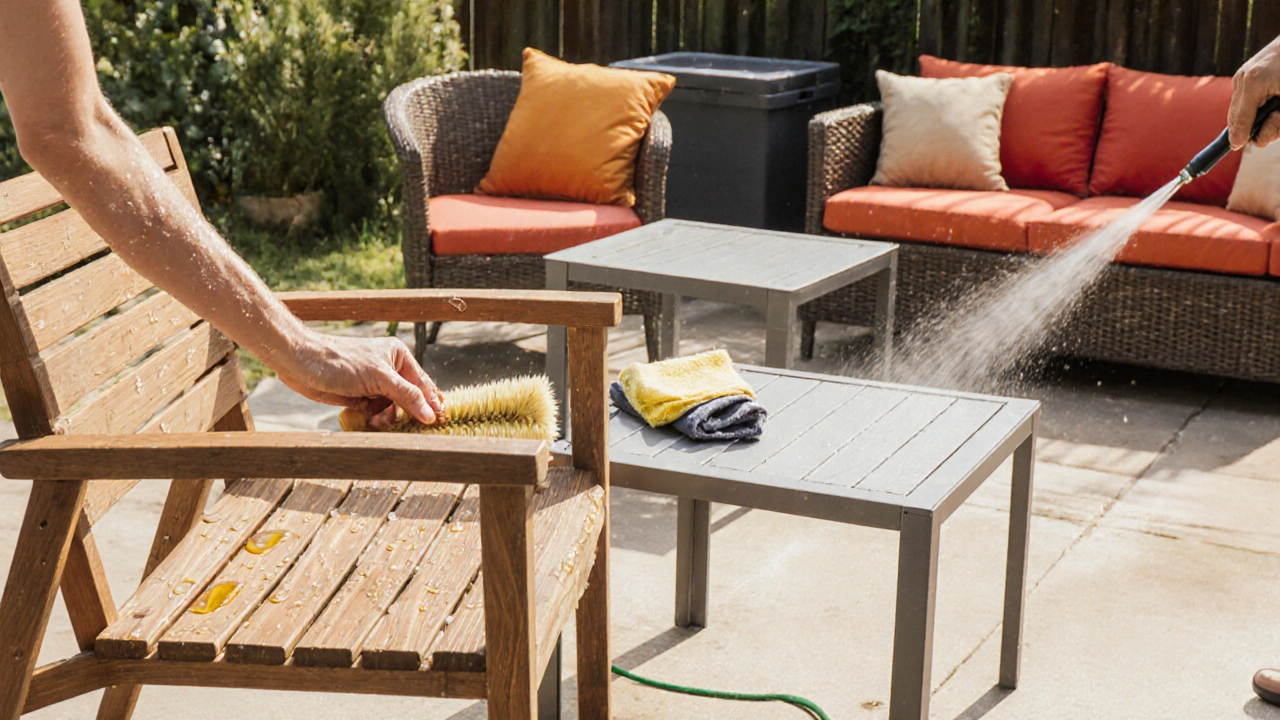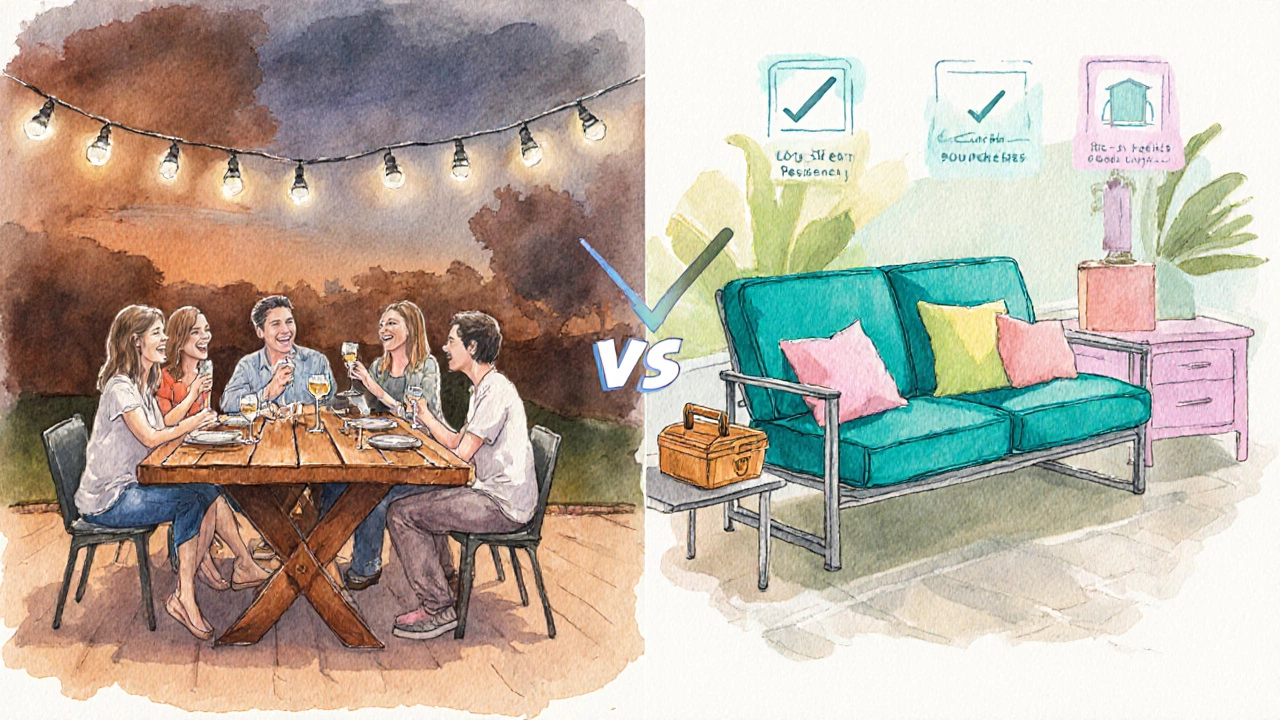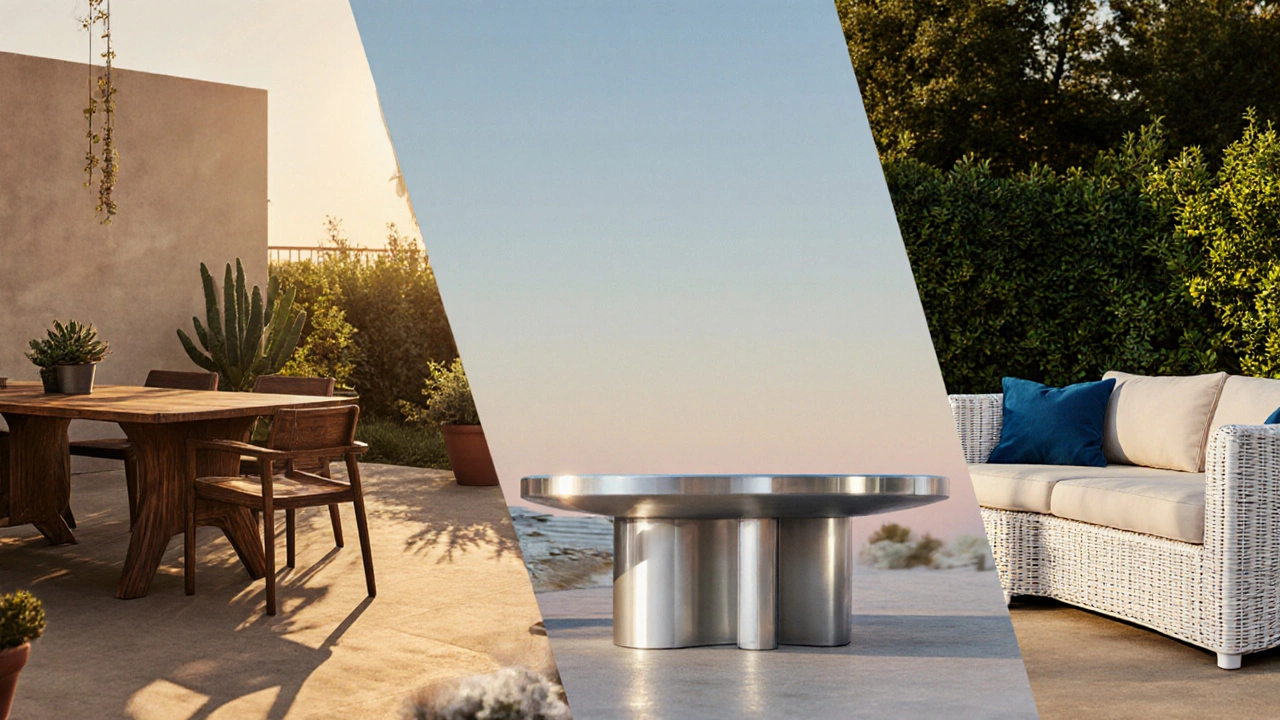When you're planning a backyard oasis, outdoor furniture is the centerpiece that sets the vibe. These are pieces designed to endure sun, rain, and the occasional summer party. But the moment you start hunting, the price tags can make anyone pause. Is it smart to drop a few thousand dollars on a expensive garden furniture set, or can a modest budget still give you a stylish, long‑lasting patio? This guide walks you through the real reasons high‑end pieces cost more, how they hold up over time, and the exact questions you should ask before you pull out the credit card.
Why Some Outdoor Furniture Carries a Premium Price
Notice the price gap between a basic metal table and a handcrafted teak set? The difference usually boils down to three factors:
- Material quality: Natural woods like Teak are dense, oily, and naturally resistant to rot, while Aluminum frames get a factory‑applied powder coat that hides scratches.
- Craftsmanship: Hand‑stitched, kiln‑dried joints, and heritage manufacturing methods add labor costs that mass‑produced pieces simply don’t have.
- Design pedigree: Brands like Brown Jordan invest in ergonomics and timeless looks, charging a premium for the name and reputation.
Understanding these drivers helps you decide whether you’re paying for genuine durability or just a fancy label.
Durability vs. Price: Material Breakdown
Below is a quick side‑by‑side look at the three most common high‑end materials. Use it as a cheat sheet when you’re weighing options.
| Material | Typical Cost (per seat) | Life Expectancy | Maintenance Level | Weather Resistance |
|---|---|---|---|---|
| Teak | $300‑$800 | 25‑30 years (if oiled) or 15‑20 years (if left natural) | Annual oiling recommended | Excellent - natural oils repel water and insects |
| Aluminum | $150‑$400 | 20‑25 years | Wipe‑clean; no coating touch‑up needed | Very good - powder coat resists rust |
| Synthetic wicker (e.g., resin or polyethylene) | $200‑$600 | 15‑20 years | Occasional hose down; avoid harsh chemicals | Good - UV inhibitors reduce fading |
Notice how the price gap isn’t huge for many aluminum or synthetic wicker pieces that still offer solid durability. If you love a natural wood look, teak’s longevity usually justifies the higher upfront cost-provided you’re ready for the yearly oiling ritual.
Hidden Costs: Maintenance, Replacement, and Longevity
Buying a pricey set can feel like a one‑time expense, but real ownership includes ongoing costs:
- Cleaning supplies: Specialized cleaners for teak or UV‑stable fabrics can run $20‑$50 per year.
- Protective accessories: A good set of UV‑resistant cushions may need replacement every 3‑5 years, costing $100‑$300 each.
- Storage solutions: If you live in a climate with harsh winters, a waterproof storage box or indoor garage space adds $150‑$400.
- Repair or refinishing: Scratches on powder‑coated aluminum can be touched up for $30‑$80, while teak that has cracked may need professional sanding and resealing ($200‑$500).
Factor these into your budget calculator. A $2,000 teak set that lasts 30 years with $500 total upkeep may still be cheaper per year than a $1,000 aluminum set that needs a $300 storage unit and cushion replacement every 3 years.

When Does Splurging Make Sense?
Not every backyard needs a museum‑level investment. Here are three scenarios where a high‑end purchase actually adds value:
- Entertaining hub: If your patio hosts weekly barbecues, guests will notice and appreciate a cohesive, upscale look. The aesthetic boost can translate into a more welcoming environment and even higher resale impressions when you sell your home.
- Harsh climate: In areas with intense sun, salty air, or frequent rain, premium materials like teak or powder‑coated aluminum resist warping and rust far better than cheap plastics, saving you replacement headaches.
- Long‑term residency: Planning to stay in the same house for a decade or more? Investing now means you’ll likely outlast your mortgage, and the furniture becomes a permanent fixture rather than a disposable trend.
If none of these apply, you might be better off scaling back and focusing on durability rather than brand cachet.
Budget‑Friendly Alternatives That Still Shine
Let’s face it: a $3,000 patio set isn’t realistic for most families. Below are three cost‑effective options that mimic the look of high‑end pieces without the sticker shock:
- Resin wicker with a teak‑look finish: Brands like Polywood offer molded resin that’s painted to resemble teak grain. Prices start around $120 per chair.
- Powder‑coated steel frames: While aluminum is lightweight, powder‑coated steel provides similar rust resistance at half the price. Look for sets under $500 from retailers such as IKEA.
- DIY refurbish: Purchase a vintage steel or aluminum set from a thrift store and repaint with rust‑proof spray paint. A fresh look for $80‑$150, plus the satisfaction of a custom finish.
These alternatives still pair well with high‑quality cushions, so you don’t sacrifice comfort.

Quick Decision Checklist
- Do you entertain frequently? Yes → consider high‑end, durable materials.
- Is your climate extreme (high UV, salty air, heavy rain)? Yes → prioritize teak or powder‑coated aluminum.
- Will you stay in the home >10 years? Yes → a bigger upfront spend can pay off.
- Do you have a dedicated storage space? No → factor in $150‑$400 for a storage solution.
- Is your budget under $1,500? No → explore resin wicker or DIY refurbish options.
Run through these points, and you’ll walk away with a clear picture of whether an upscale purchase aligns with your lifestyle and wallet.
Final Thoughts
Expensive garden furniture isn’t a one‑size‑fits‑all answer. Its true worth depends on material durability, climate, usage patterns, and how long you plan to keep it. By comparing material specs, adding up hidden costs, and checking your personal criteria, you can decide if that $2,900 teak set is an investment or a splurge. Remember, the goal is to create a patio you love-whether that comes from a $300 aluminum lounge or a $3,000 handcrafted masterpiece.
How often should teak outdoor furniture be oiled?
For optimal protection, apply a thin coat of teak oil once a year, ideally after the rainy season. If the wood looks dry or loses its natural golden hue, it’s time for another round.
Can I leave synthetic wicker outdoors year‑round?
Yes, high‑quality resin wicker is designed to withstand UV exposure and moisture. Just keep it clean and avoid abrasive chemicals, and it should stay vibrant for 15‑20 years.
Is powder‑coated aluminum truly rust‑proof?
The powder coating creates a barrier that prevents rust under normal conditions. If the coating chips, expose the metal and touch up with a matching powder‑coat spray to keep it protected.
What’s the best way to store outdoor cushions in winter?
Dry them completely, then zip them into a waterproof storage bag. Keep the bag in a garage or basement-never leave them exposed to frost, which can cause the foam to crack.
Are there any tax deductions for buying premium outdoor furniture?
Generally, personal outdoor furniture isn’t tax‑deductible. However, if you run a home‑based business and the patio is used for client meetings, a portion might qualify as a business expense-consult a tax professional.

